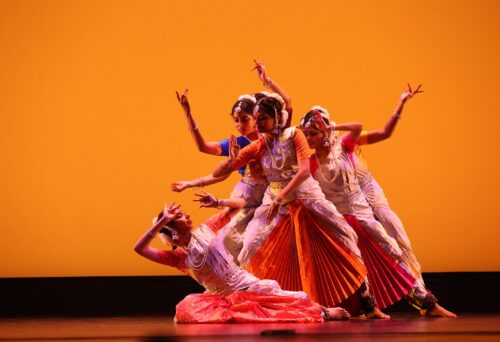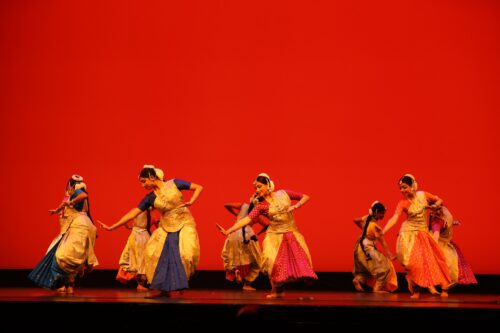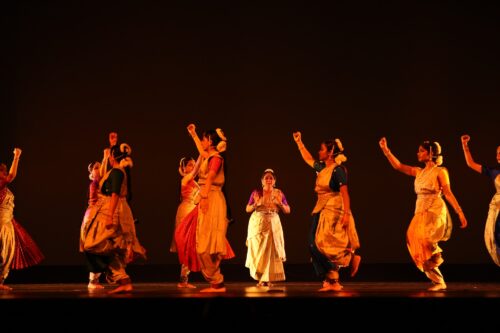Silambam Celebrates Indian Independence in Waking Up Free

The great Indian subcontinent celebrated seventy-five years of independence from British colonial rule on August 15, 2022. To commemorate this significant milestone, Silambam Houston, under the executive and artistic direction of Lavanya Rajagopalan, presented Waking Up Free: India’s Journey, on March 31, 2023. The evening-length production, created in collaboration with Shri Silambam Academy in Chennai, chronicled the subcontinent’s path to independence through the classical dance form of Bharatanatyam.
To illustrate the history of an entire country through dance is a true endeavor, but Rajagopalan found a poetic device that worked quite well. She structured the production’s historical content to mirror the stages of a Margam, which is the traditional progression of Bharatanatyam choreography, to create five distinct sections of narrative-driven dance.
The opening Thodayamangalam pays tribute to the kingdoms and empires of ancient India. I found this section to be most representative of Rajagopalan’s choreographic style, which is highlighted by beautiful ensemble work and an eye for rich composition. It’s common for classical Indian dancemakers to utilize simple formations when working with large casts, but Rajagopalan favors complexity in her arrangements. There are often multiple things happening at once, and her tableaus are not static, but undulating and opulent.

I really enjoyed one particular sequence where the entire ensemble was arranged in a series of miniature scenes that filled the stage. As two characters visited each tableau, the members of that group became animated before settling into their still shapes again. The pops of movement jutting out of the frozen landscape of lovely human forms was so pleasing to watch. The entire opening section was stunning, and I could see it being used as a standalone repertory piece.
The second section, or Jathiswaram, focuses on the arrival of the British East India Company, which marked the beginning of India’s colonial era. Here, abstract movement is used, and the attention shifts to the intricate footwork. The gestures become more detailed and the dancing of the upper body becomes grander. The choreography in this section is equally beautiful, and even more musical than in the first.
Even though this section is epitomized by abstract interpretations of the classical vocabulary, it ends with a bit of narrative staging. Half of the ensemble is on the floor, reacting to the menacing gesticulations of the standing half. For me, this scene represents the oppressiveness of British tactics to subdue the Indian subcontinent. The subjugation took more than 200 years to complete, and often involved turning the diverse people of India against one another.

Waking Up Free then moves to the Varnam, which is characterized by emotive expression. Here we witness the tyranny of British rule and the revolutionary acts of several notable figures from history, some known to the general public and others all but lost to history. There are many scenes of combat in this section, as well as a stunning moment that sees the dancers file off stage and into the audience before marching back on at the opposite side. The parade is a clear visual reference to the act of protest.
There is much to cover in this third act, but I think perhaps a bit of editing was needed. It felt long and tedious, and this was the one section where I think the voiceover had to do the heavy lifting. The choreography is now in the service of telling history, which is why I think the production loses a bit of steam here.
A highlight, though, is that the many episodes of conflict are anchored by the satisfying presence of the two figurative matriarchs of the project, Priya Murle and Lavanya Rajagopalan. Their duet at the end of this section is joyful, effulgent, and the product of lifelong artists. Their dancing reminded me of the soft patter of rain.
The momentum picks up again with the Medley, which attempts to convey the cultural complexity of the Indian subcontinent. Vignettes portray different regions of the country, each with its own language, customs, and traditions. Hindu, Muslim, and Christian communities are referenced, along with various styles of classical and folk dance. The medley concludes with the staging of Odissi, Kathak, and Kuchipudi dance into one satisfying choreography.

The concluding Thillane is a celebratory dance, and we return to the bright colors and pretty ensemble work that began the evening. The dancing is appropriately softer and quieter as an evening full of meaning and reflection comes to a close.
There is much to enjoy in Silambam’s productions. But I leave Waking Up Free contemplating the element of narrative in dance. For me, Waking Up Free had its finest moments when the choreography was not saddled with a narrative task. While I understand classical Indian dance to be an inherently narrative form, I think dancemakers in the tradition are often at their best when creating with the beauty of their vocabulary at the forefront. The classical Indian styles are all breathtaking, and I find inspiration in them even if there is no program or director notes at hand.
I imagine Waking Up Free was an incredible effort, and Rajagopalan handled it with skill. I hope those who came for the history left wanting to see more of her choreography and her company’s dancing.



Recent Comments